Parrot Paradox: The Unprotected, Endangered Red-crowned Parrot
How humanity threatens, benefits, and can save an endearing, range-restricted bird.
The Red-crowned Parrot could be a poster-bird for the travails facing wild parrot populations around the world. Pummeled for decades by the one-two punch of habitat loss and capture for the bird trade, this chunky green bird with red cap and wing flashes has vanished from 50 to 85 percent of its original range, its population down an estimated 95 percent. Not surprisingly, the International Union for Conservation of Nature (IUCN) lists the species as Endangered. But there is a silver lining: Usually a bird of remaining wild, scrub-forest habitat in its small range in northeastern Mexico, this parrot now also occupies South Texas suburbs in a big way. Scientists studying the birds both north and south of the border hope that by tapping into our affection for these colorful, intelligent birds — and appreciating them as wild birds, not prospective pets — that the Red-crowned Parrot can be saved, both in town and country.
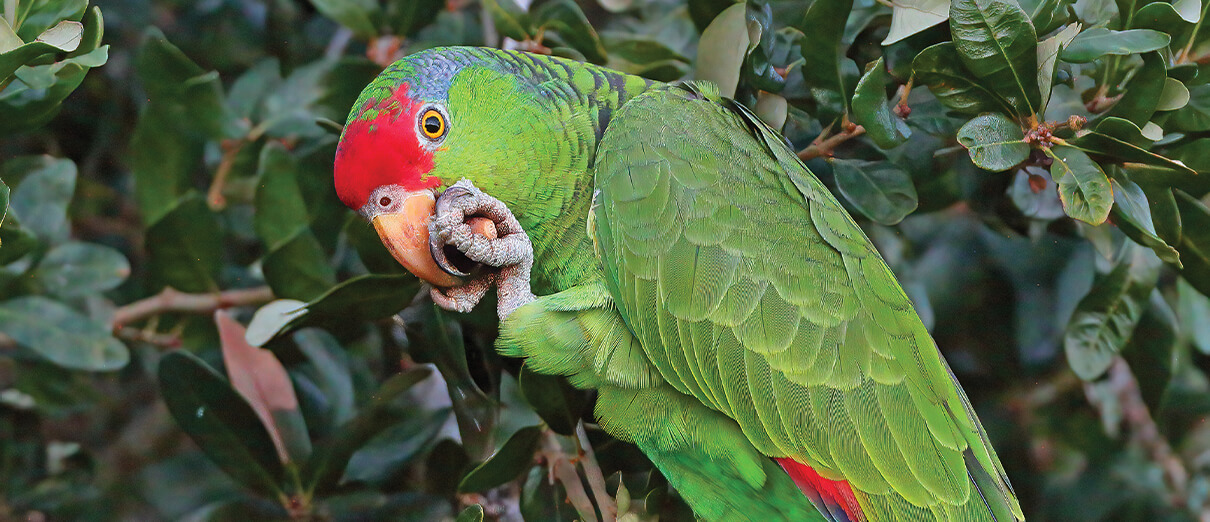
Dexterous and surprisingly well camouflaged as they quietly forage in trees, Red-crowned Parrots have proven they can live alongside people, as long as people can “live and let live.” Photo by Greg Homel/Natural Elements Productions
Birds of the Burbs
In the subtropical climate of Texas's Lower Rio Grande Valley (LRGV), suburban yards, shopping centers, and a city park now shelter a robust Red-crowned Parrot population based in four cities — Brownsville, Harlingen, McAllen, and Weslaco.
“It's clear that these parrots want what the people want,” says Simon Kiacz, a Texas A&M Ph.D. graduate student who has been studying the South Texas birds since 2016 as part of the Tejano Parrot Project, working with volunteers to study the region's four roosts. Kiacz wrote his dissertation on these birds and coauthored the only definitive recent study of the population, published in the journal Bird Conservation International in 2020.
“Every single nest, roost, and feeding tree we have confirmed has either been planted or facilitated by a person,” says Donald J. Brightsmith, a Texas A&M biology professor and coauthor of the paper. “That's completely the opposite of most every bird population we're trying to protect in remnant populations.”
“I don't know of any evidence that we have flocks of them outside the urban interface, and I don't know of any anecdotes or complaints or studies from agricultural folks saying the parrots damage anything,” adds Tony Henehan, another of the paper's coauthors, who is a wildlife biologist with the Texas Parks and Wildlife Department. Henehan coordinates quarterly parrot roost counts in the LRGV, most of which are carried out by local volunteers recruited by two groups, Arroyo Colorado Audubon and Texas Master Naturalists.
The current LRGV population is estimated at about 700 birds, remaining steady the last three to five years, after increasing for decades. Roughly 110 miles from the northern limit of the bird's Mexican range, this satellite population is considered by the paper's authors to be “an important reservoir for this endangered species.” Redcrowns are now found in other parts of the U.S. as well, including Hawai‘i, Puerto Rico, Florida, and especially southern California, home to approximately 3,700. All together, the total U.S. population, estimated at roughly 4,700 birds, may outnumber the estimated remaining wild Mexican population of 2,000 to 4,300 adults.

Red-crowned Parrot dining, by Simon Kiacz
The four large South Texas roost sites are occupied much of the year, ebbing during nesting season. The Brownsville roost remains more or less static, but participants in the other three roosts switch locations from time to time. Each day, the birds gather at dusk in noisy congregations, then silently settle at roost perches by nightfall. Just before sunrise, they reverse the process. The birds' raucous calls are hard to ignore. “But once the birds are quiet and they're done settling in to roost, you wouldn't know they're in the trees right over your head,” says Kiacz. “People will roll right up to these birds and park their cars, or the pizza guy stops by, and they have no idea there are 200 birds right above their heads.”
What do local residents think of their green-feathered neighbors? “Overall, there's definitely a positive view of these birds,” says Kiacz. “The people who have them nesting and roosting in their yards have a really strong connection with them. Although sometimes you see people obviously just woken by the birds, who come out clapping their hands.”
Origins of the Species (in Texas)
Many have assumed the South Texas Redcrown population originated solely from escaped cagebirds, but due to the area's close proximity to the native range in northeastern Mexico, there's been decades of debate about whether or not natural pioneers form part of the LRGV birds' legacy. All the sources interviewed for this article believe the population has included at least some Mexican birds that flew there themselves. Jesús Franco, an ABC conservation biologist and Assistant Coordinator of a binational bird conservation partnership called the Rio Grande Joint Venture (RGJV), lives in South Texas. He has studied the species both there and in Mexico, in submontane forest on the eastern flanks of the Sierra Madre Oriental mountain range.
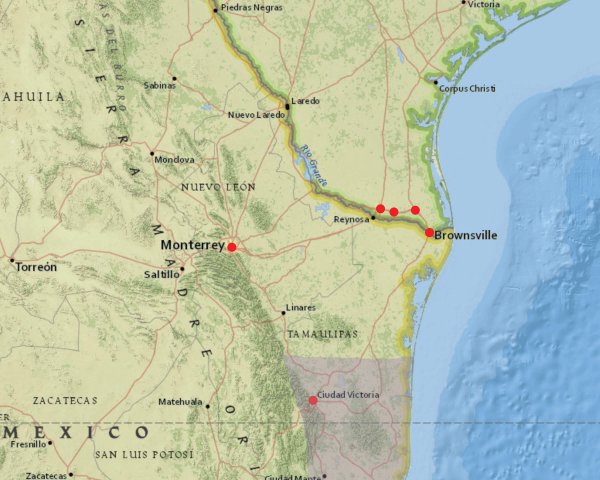
Map showing the four Lower Rio Grande Valley cities with Red-crowned Parrot roosts and their proximity to the northern portion of the species' Mexican range (shaded in gray). Monterrey, Mexico also has a population.
Franco explains why he believes not all Redcrowns originate from introduced birds: “In Mexico, the Sierra Madre Oriental forms a natural barrier that can channel birds like the parrots, if they have to move, northward and close to the U.S. border. This can help one safely assume that when the right conditions came together, it could have been natural dispersal that occurred along this corridor,” he says. “But there's currently no way to prove the origins one way or another. At least, no one has done it yet.”
Although not considered migratory, Red-crowned Parrots sometimes disperse, particularly outside the breeding season. This usually happens in times of severe winter weather or drought, when the birds may wander relatively long distances seeking sustenance. For their paper, Kiacz and his colleagues collected past records, writing: “In 1885, the Galveston Daily News reported that travelers were seeing flocks of parrots as close as 34 km (21 miles) south of Brownsville, Texas. Also in 1885, a south Texas newspaper reported flocks of parrots north of Brownsville and noted this as the first instance of these birds being seen in Texas.” The once-abundant Redcrown is the species most likely seen.
Occasional LRGV reports of parrots followed, but the first nesting-season sightings there came in 1976, followed by confirmed nesting in Harlingen in 1985. By the early 1990s, the parrots nested in all four roost-site cities. Why the sudden uptick in birds in the late 20th century? Most experts believe that this jump was fueled by the cross-border bird trade. According to sources cited in Kiacz and his colleagues' paper, through the 1970s and early 1980s, the flow of legally and illegally transported birds into the U.S. is estimated to have included more than 30,000 Redcrowns — more than six times the current total estimate for the Mexican population — most coming through South Texas. Subsequent legislation banning wild-parrot imports, tighter import controls in general, and reduced wild Mexican parrot populations mean that few if any illegal birds arrive now.
But in their paper, Kiacz, Brightsmith, and their colleagues posit that the winter of 1983-1984 might also have sparked natural changes. Then, an historic freeze in the region likely forced Mexican birds outside their normal range, with some heading north. Meanwhile, the same freeze killed large numbers of palms in South Texas, leaving legions of dead, standing nest trees for arriving, cavity-nesting colonizers.
Long assumed by many to be nonnative and sedentary, U.S. Red-crowned Parrots sit in legal limbo, lacking federal protections other small bird populations garner under the Endangered Species Act (ESA) and Migratory Bird Treaty Act. The species was passed up for ESA listing in 2019. Although the U.S. Fish and Wildlife Service recognizes the South Texas population as native, it declared listing it was not justified because the U.S. population was not declining and because the rate of habitat loss in Mexico has not been as high as in prior decades.
The state of Texas, meanwhile, now classifies the parrot as native, after reviewers considered historical parrot records in the LRGV, as well as the likely pathway Mexican birds take north when dispersing. Texas is also in the process of modifying its threatened species list, and likely will soon declare the Redcrown “threatened.”
A source of local pride, the Red-crowned Parrot is protected in the four roost cities. Brownsville has even designated it the city's official bird, its likeness appearing on a prominent underpass and elsewhere. The parrots help generate hundreds of thousands of dollars in local income, drawing visiting birders who descend upon the region each year to attend several annual birding festivals or to chase “border birds” on their own.
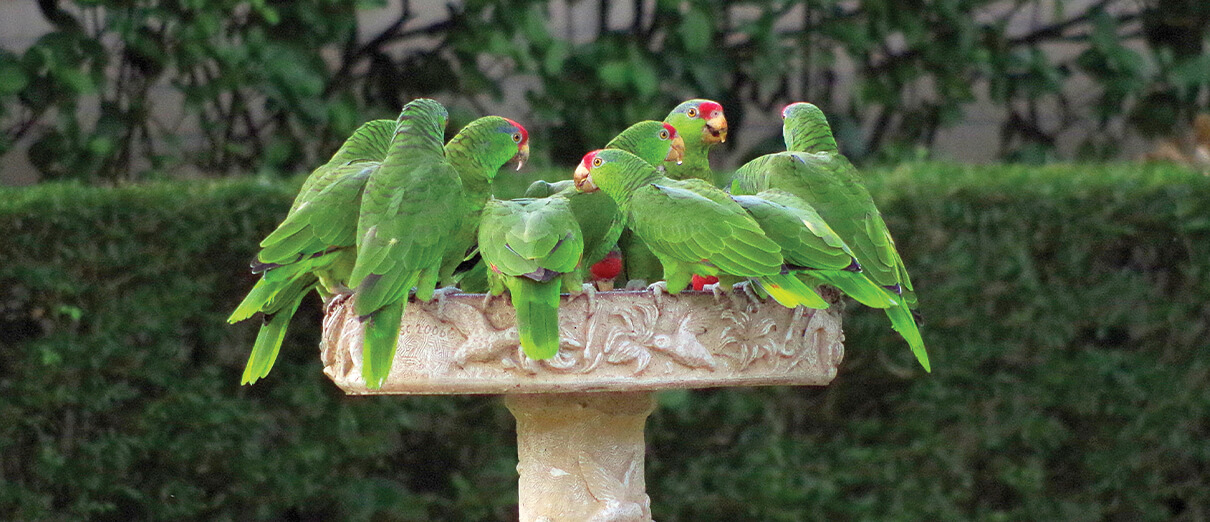
Mostly a bird of natural habitats in northern Mexico, the Red-crowned Parrot is very much a bird of the burbs in the U.S. Photo by Simon Kiacz
Eyeing the Future
Among the goals of the South Texas study and roost counts was to determine the Redcrown population's size and health, and to start to understand how to secure its future in a rapidly developing region. The results affirmed that even with urban parrots, nothing can be taken for granted.
“The population really increased drastically for many years, but once we started doing really good counts on them, we see the population has leveled off the last three to four years,” says Texas A&M's Brightsmith. “This begs the question: Why explode for so long and level off? Perhaps they are not necessarily in equilibrium with their habitat, but getting close? Is poaching enough of a problem in Texas to depress the population? Or are there nest site limitations? We didn't think so, but if you throw out the other stuff, it's one thing that's left in the basket.”
“I think the really big threat they face is the loss of nest sites,” says Texas Parks and Wildlife's Henehan. “The parrots seem to prefer palm trees, but one of the things that happens to dead trees in urban areas is that they get cut down. They are considered ugly, or they might hurt someone or a building.”
Conserving dead standing trees and making careful landscaping choices will be important components of any plan to help the parrots. “The plants that homeowners and municipal governments are putting on their lands — these are the future habitat for these birds,” adds Brightsmith. Many Texas Redcrowns nest in cavities in introduced fan palms of the genus Washingtonia, a now-iconic regional tree accenting towns and farm-field borders. “If you don't provide these,” says Brightsmith, “you're not providing future nest sites for the species.”
Meanwhile, poachers target some of the remaining nest trees. During the study, Kiacz and others regularly noted telltale marks and cuttings in trees indicating the removal of young birds by people. Locally captured birds are sometimes seen being sold at local flea markets.
The parrots face other suburban threats as well. “I'm concerned about feral cats,” Henehan says. “I've seen cats on rooftops trying to grab parrots. There are sponsored cat colonies in some communities, and feral cats are just so widespread down here that I wouldn't be surprised if some part of their diet consists of parrots.” In addition, the birds face competition for available nest sites from other birds, including the plentiful Black-bellied Whistling-Duck, the also-naturalized Green Parakeet, and, uncommonly, squirrels.
Although they face challenges, the South Texas Red-crowned Parrot population has many local fans and likely will persist, and hopefully grow once again, alongside the LRGV's expanding human population. But what about the core population in northeastern Mexico? Luckily, ABC and partners have been looking into that, studying how communities can embrace and protect these birds.
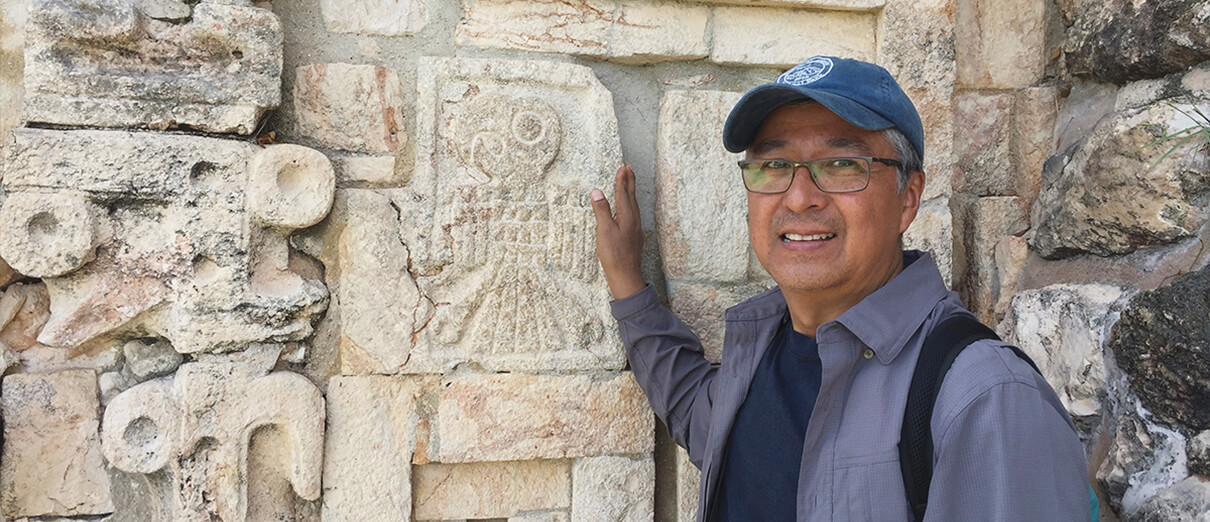
ABC's Jesús Franco poses with a parrot petroglyph at the Uxmal ruins in Mexico's Yucatán Peninsula. Photo by Salvador Narváez Torres
South of the Border
Concerned about the species' dwindling numbers and shrinking range in northeastern Mexico, researchers from ABC, the RGJV, and Mexican partner Terra Asesoría Ambiental studied the parrots in four municipalities in Tamaulipas state from 2017 to 2019. Their goals were to determine the species' status in a large portion of the Mexican range, to identify key parrot hotspots, and to provide a foundation for a recently drawn-up conservation plan, which has since been produced. During the study, researchers and local volunteers counted Red-crowned Parrots at 34 roost sites, tallying 1,789 birds in a four-county area.
“After two years of field monitoring, we now have a conservation plan and have identified the sites where we need to prioritize the work,” says ABC's Franco. “But the thing you don't want to see is a conservation plan living on the bookshelf. Therefore, I'm super-excited to see ABC stepping up to the plate to provide the first round of funding to begin the implementation of the conservation action plan that we've made for the Red-crowned Parrot in Tamaulipas.”
With an agreement recently signed with Mexican partner Pronatura Noreste, ABC plans to take action starting in 2021. The Tamaulipas State Commission for Parks and Biodiversity will also join in these efforts. Part of the plan is to work with residents in each community to train and certify them as environmental interpreters/guards. “The main objective is to strengthen local capacity to conduct ecotourism and birding activities, as well as to assist local enforcement agencies by conducting monitoring and surveillance activities around nesting areas,” says Franco.
To help support this project, ABC and Pronatura Noreste are partnering with Defenders of Wildlife Mexico to produce educational posters and bird identification pamphlets promoting birdwatching as an alternative source of income, and raising awareness of wildlife trafficking's negative impacts. The partners are also exploring other economic opportunities that will benefit residents, such as finding new ways to market local crafts and food to visitors.
While most of Mexico's Redcrowns keep to wild areas, there are noteworthy exceptions. The large city of Monterrey has a significant population. And during their study in the heart of the bird's Mexican range, Franco and his colleagues tallied a stunning 72 Red-crowned Parrot nests in Hidalgo, a small community of 10,000 people not far from the large city of Ciudad Victoria. “These birds often live in native habitat close to urban areas,” Franco says, “but in a square in a tiny, itty bitty town, we recorded the highest nesting density we know of.”
Franco believes one reason the birds persist there is that the local people are watching out for them, discouraging poachers who might venture in from out of town. This raises the question: What if tomorrow, people stopped capturing or otherwise harassing wild, endangered parrots? “This is a really good example,” says Franco, “of what these birds can do when they find what they need and are basically left alone.”
Working together in two countries, conservationists hope this kind of parrot-friendly coexistence will become more commonplace. If successful, efforts to save the Red-crowned Parrot will not only ensure that these beloved birds remain — but also inspire other efforts to save many other declining parrots through a blend of careful study, planning, and local buy-in.
ABC would like to thank the Texas Parks and Wildlife Department, the U.S. Fish and Wildlife Service, and Kathleen Burger and Glen Gerada for their generous support.
READ MORE: Parrots of the USA
The popularity of parrots as pets has helped spawn naturalized populations, particularly in warmer parts of the country. Long-lived social creatures, parrots often prove challenging pets, requiring more space and care than many owners anticipate. Many escape captivity or are released deliberately.
About two dozen parrot species have U.S. breeding populations. The Monk Parakeet is considered a pest by electric utilities because, unlike most other parrots, this species builds bulky, communal nests that, when stuffed into electrical gear, pose the threat of power outages and fire. So far, the mostly urban naturalized parrots do not seem to compete heavily with native cavity-nesting species.
Here, eight of the most populous species are listed, as are two native species that have vanished — one extinct, the other extirpated (gone from the region).
Bird art © David Allen Sibley
|
|
|
|
Rosy-faced Lovebird |
|
|
|
|
 | Howard Youth is ABC's Senior Writer/Editor, and is the author of Field Guide to the Natural World of Washington, D.C. |





































 Monk Parakeet
Monk Parakeet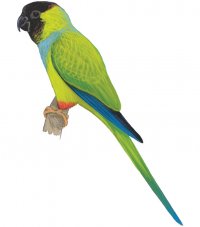 Nanday Parakeet
Nanday Parakeet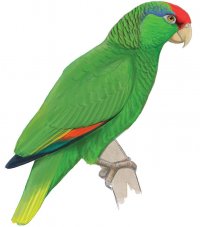 Red-crowned Parrot
Red-crowned Parrot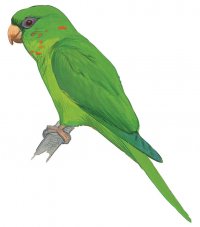 Green Parakeet
Green Parakeet
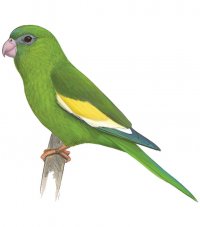 White-winged Parakeet
White-winged Parakeet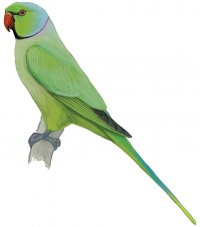
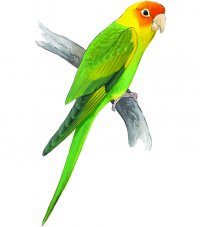 Carolina Parakeet
Carolina Parakeet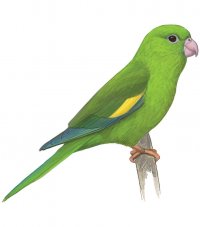 Yellow-chevroned Parakeet
Yellow-chevroned Parakeet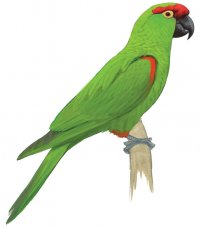 Thick-billed Parrot
Thick-billed Parrot












